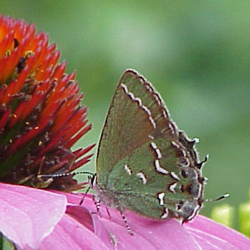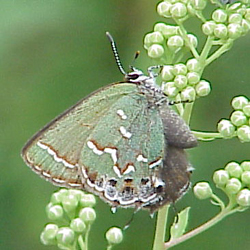Find a Butterfly
Juniper Hairstreak
Callophrys gryneus
Named
Hubner, 1819

Taxonomy & Nomenclature
Recently "lumped" with other western taxa of the genus Mitoura. Formerly widely known as the Olive Hairstreak.
Identification
Wingspan: 7/8 ‑ 1". Can only be confused with Hessel‘s Hairstreak (see discussion under that species); generally separable by habitat alone.
Distribution
Southernmost British Columbia east to southern Maine and south throughout most of the United States, into northwest Mexico. In New England, occurs north to southern Vermont, New Hampshire, and Maine.
Status in Massachusetts
Scudder noted the species north to the general vicinity of Boston and the lower Connecticut Valley in Massachusetts, seldom in abundance. It is known today to be widely distributed and quite common in eastern Massachusetts, although it is absent from the major islands south of Cape Cod. In central and western Massachusetts it is apparently much more local, and during the Atlas it was found in only a few localities in or near the southern Connecticut Valley. Juniper Hairstreaks are found in close proximity to the food plant Eastern Red Cedar (Juniperus virginiana), which occurs most abundantly in eastern and southeastern Massachusetts. Generally found in modest numbers (1‘s and 2‘s). Maximum: 103 on 23 May 1991, Foxboro (Norfolk Co.).

Flight Period in Massachusetts
Two broods, though the second is markedly smaller than the first: typically mid‑May to mid‑June and August, with spring extremes of 2 May and 18 June 1987, Middleboro (Plymouth Co.), K. Anderson, and summer extremes of 2 August 1986, Granby (Hampshire Co.), N. Weiss and 18 August 1989, South Hadley (Hampshire Co.), T. Fowler.
Larval Food Plants
Eastern Red Cedar (Juniperus virginiana) is the sole natural larval food source.
Adult Food sources
Chokecherry is a popular nectaring sources for spring-flying individuals. Recorded later in season at Yarrow, Common Milkweed, Oxeye Daisy, Joe-Pye-Weed, and Meadowsweet.

Habitat
Old fields with stands of Eastern Red Cedar. In western Massachusetts, Eastern Red Cedar occurs mainly on ridge‑tops. Occasional individuals wander up to several miles from the preferred habitat, seemingly in pursuit of nectaring sources.
Life Cycle
u>EGG: Pale green. OVIPOSITION: Eggs laid singly on terminal leaves. LARVA: Green, with angled white markings on the back. CHRYSALIS: Dark brown and compact. OVERWINTERING STAGE: Chrysalis
Males mate with females soon after their emergence in May and eggs are laid on 10‘ ‑ 40‘ cedars, at the tips of the freshest foliage. The larvae, which require five weeks to develop, feed on the fresh leaves. Most of the offspring of the May/June generation overwinter as pupae, but a fraction emerge in late summer to form a partial second brood. The progeny of this flight overwinter as pupae.
Scudder (1889) characterized the activity of the adults thus: "The butterfly is extremely active and when playing with its mates or pursuing the female, may generally be seen around the tops of cedars, of a height of about twenty feet. Here each takes up position ready to have a scrimmage with the first one that ventures on the wing, and then three or four may often be seen whirling in circles about the tree‑spires with wonderful rapidity, a play which ceases almost as suddenly as it begins."
Notes
Juniper Hairstreaks, because of their small size, cryptic coloration, and habit of perching in trees, may be difficult to detect at times. The surest way to find them is to jostle the cedar trunks with a long stick. The disturbed hairstreaks will fly out from the branch tips and usually come back to "roost" close by. With patience, excellent eye‑level views can be obtained.
Account Author
Brian Cassie
Additional Information
Read more on this species at the North American Butterfly Association.



